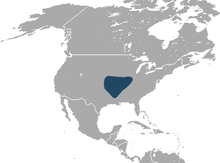Elliot's short-tailed shrew
| Elliot's short-tailed shrew[1] | |
|---|---|

| |
| Scientific classification | |
| Domain: | Eukaryota |
| Kingdom: | Animalia |
| Phylum: | Chordata |
| Class: | Mammalia |
| Order: | Eulipotyphla |
| Family: | Soricidae |
| Genus: | Blarina |
| Species: | B. hylophaga
|
| Binomial name | |
| Blarina hylophaga Elliot, 1899
| |

| |
| Elliot's short-tailed shrew range | |
| Synonyms | |
|
Blarina carolinensis hylophaga | |
Elliot's short-tailed shrew (Blarina hylophaga) is a small, slate grey, short-tailed species of shrew. Its common name comes from Daniel Giraud Elliot, who first described the species in 1899.
Description
Elliot's short-tailed shrew is similar in appearance to the closely related
The fur is velvety in texture, and uniformly colored greyish to brown. Adults range from 9 to 12 cm (3.5 to 4.7 in) in total length, including the 2-to-3 cm (0.79-to-1.18 in) tail, and weigh 13 to 16 g (0.46 to 0.56 oz).[3]
Distribution and habitat
Elliot's short-tailed shrew is found in lowland environments with heavy vegetation from southern Iowa and Nebraska in the north to parts of Texas and northern Louisiana in the south, including much of the states of Missouri, Kansas, Oklahoma, and Arkansas, and the northeastern corner of Colorado.[2] Two subspecies are currently recognised:
- Blarina hylophaga hylophaga - throughout most of range
- Blarina hylophaga plumbea - Texas
The species inhabits a diverse range of habitats, including grasslands, agricultural land, and woodland. Although it generally prefers well watered environments with plenty of ground litter, it is also known from relatively dry and sandy terrain in Texas and Colorado, often with minimal ground cover.[3]
Behavior and diet
Like other shrews, this species is
Elliot's short-tailed shrew is generally a solitary, nocturnal animal, spending the day sleeping in burrows in soft soil or leaf litter. The burrows may contain nests made from grass or leaves, and are surrounded by a network of trackways that the shrew uses while hunting for prey. They have been reported to travel across home ranges of anything from 0.06 to 0.55 hectares (0.15 to 1.36 acres), and to travel mostly around dawn and sunset. Having poor eyesight, they hunt primarily by means of echolocation. They are active throughout the year, and do not hibernate.[3]
Reproduction
The shrew breeds from early spring to late summer, and may be able to raise two or three litters per in a year. Gestation lasts 21 or 22 days, and results in the birth of four to seven hairless young. The young are weaned, with a full coat of fuzzy hair, by one month of age, not receiving the adult coat until they have reached adult size. Individuals can live for up to two years.[3]
Taxonomy and evolution
Elliot's short-tailed shrew was originally described as a subspecies of
References
- OCLC 62265494.
- ^ a b Hammerson, G. (2008). "Blarina hylophaga". IUCN Red List of Threatened Species. 2008. Retrieved 7 February 2010.
- ^ doi:10.1644/878.1.
- S2CID 86334639.
- .
- PMID 11820838.

